As a pest control business owner, you work hard to rid homes of unwelcome pests – but are you doing enough to attract and retain customers? In today’s competitive market, smart marketing is essential for sustained growth. That growth brings opportunity, but also intensified competition. Homeowners have more options than ever, and big national brands invest heavily in advertising to dominate local markets. To thrive, your pest control company needs a proactive marketing strategy that keeps your phone ringing year-round.
This guide will walk you through practical, data-driven marketing strategies to help grow your pest control business. We’ll cover why marketing matters for pest control, how to build recurring revenue with service plans, ways to earn trust through reviews and reputation, the best digital marketing channels and how to use them, as well as how to tailor your marketing to seasonality and route density for maximum efficiency. Throughout, we’ll highlight real success stories of pest control businesses that achieved impressive growth by using these strategies. By the end, you’ll have a clear roadmap to attract more customers, drive recurring revenue, and outshine the competition. Let’s dive in!
Why Marketing Matters in Pest Control
Many pest control business owners rely on word-of-mouth, door-to-door, and repeat customers – which are great, but may not be enough to reach your growth goals. Effective marketing matters in pest control for several key reasons:
- High competition for urgent needs: When a homeowner finds termites or a wasp nest, they need help fast. They’ll often search online and call the first reputable company they find. If your business isn’t visible in those moments of need, a competitor will get the call. Marketing ensures you show up where and when potential customers are looking for pest services.
- Changing consumer behavior: Today’s homeowners overwhelmingly turn to Google and online reviews to find local services. This means your reputation on the web directly impacts whether customers choose you. A solid marketing strategy manages your online presence so you look trustworthy and easy to find.
- Growing market, growing opportunity: The pest control industry is on a strong growth trajectory, with rising demand as more people prioritize professional pest services. More demand brings more opportunity to win new customers – but only if they know about your services. Marketing helps you capture your share of this expanding market.
- Seasonal slowdowns: Pest activity fluctuates with seasons – for example, many regions see pest issues spike in spring and summer and slow down in winter. Without marketing, you might experience feast-and-famine cycles. A strategic marketing plan allows you to generate leads year-round, smoothing out seasonal dips by promoting relevant services (like rodent control in fall or overwintering pest prevention) during slower months.
- Fuel for growth: If you have goals to expand into new territories or increase revenue, marketing is the engine that drives growth. It’s not just an expense, but an investment – when done right, every dollar you put into marketing can return multiples in new business.
Pro Tip: Marketing isn’t just about ads. It's about making sure your ideal customers find and trust you when they need you.
Real-World Example: Consider PESTOUT, a pest control business that was down about 15% in revenue early in the year – a potentially serious setback. By doubling down on marketing (especially search engine optimization and online reputation management), PESTOUT managed to not only recover but thrive.
They transformed that 15% deficit into a 5% revenue increase, ultimately achieving a 20% jump in revenue for the year.
Marketing made the difference by improving PESTOUT’s online visibility and credibility, leading to a surge of new customers. This illustrates how effective marketing can turn around a slow period and drive real growth.
Drive Recurring Revenue by Promoting Service Plans
One of the smartest strategies for any pest control business is to build up recurring revenue through service plans (also known as maintenance plans or subscription services). Instead of fighting for one-off jobs all the time, you lock in customers for ongoing, scheduled treatments (monthly, quarterly, or annual pest prevention services). Marketing can help you promote these plans and highlight their value to customers. Here’s why recurring revenue is so valuable – and how to grow it:
- Stability and predictability: Recurring service plans provide a steady income stream you can count on. This helps balance out seasonal highs and lows. Even in winter when new calls might slow, your subscribers keep revenue coming. For the business owner, it means easier forecasting and less stress about covering expenses during slow months.
- Higher lifetime value: A customer on a yearly pest prevention plan will generate far more lifetime revenue than a one-time caller. They’re also more likely to stick with you year after year, especially if you provide great service. Marketing to existing customers (for example, through email newsletters or follow-up calls) about joining a maintenance program can significantly improve their lifetime value to your business.
- Improved efficiency: When you have many clients on route-based service schedules, you can optimize your technicians’ routes (we’ll discuss route density more later). You’ll service clusters of customers in the same area, reducing drive time. This means more productive hours killing pests instead of driving, which increases your profit margins. Recurring customers scheduled by area make your whole operation more efficient.
Pro Tip: Highlight the convenience, savings, and peace of mind these plans offer. Add testimonials from happy subscribers to build trust.
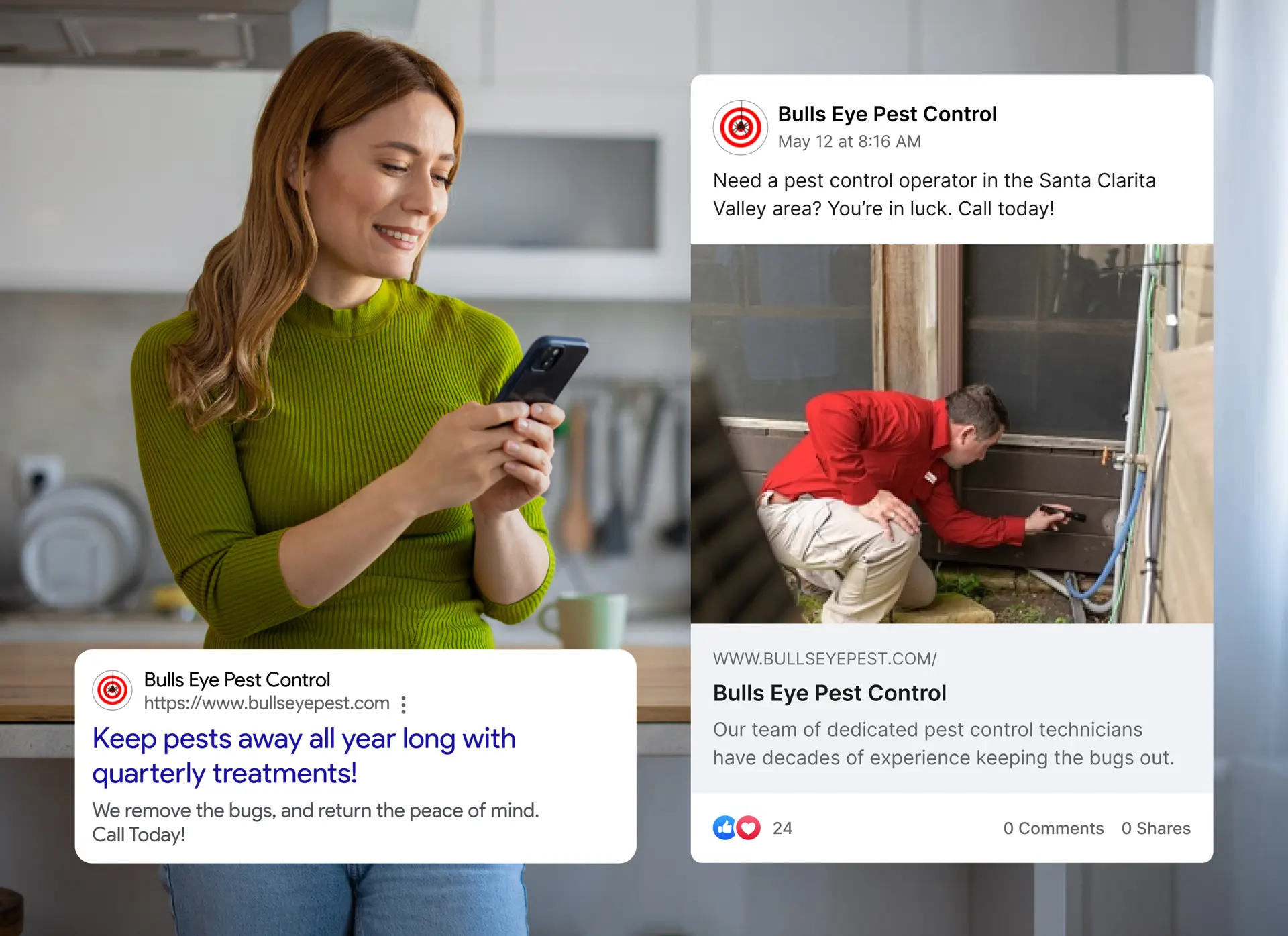
How to Promote Recurring Service Plans
Marketing plays a key role in convincing customers to sign up for ongoing service. Some actionable tactics include:
- Highlight the benefits: Ensure your website and sales materials clearly explain the advantages of your pest control plans – e.g. “Keep pests away all year long with quarterly treatments!” Emphasize convenience (automatic scheduling), cost savings (bundled pricing or discounts versus one-off calls), and peace of mind (“protect your home 24/7 from infestations”).
- Offer incentives: Consider promotions like a first service free or a discount when customers commit to an annual plan. For example, “Sign up for our Home Protection Plan and get 10% off your first year.” Limited-time offers can create urgency for new customers to opt into a plan.
- Train your team to upsell: Your technicians and sales reps should educate one-time job customers on why ongoing prevention is important. After solving an immediate pest issue, they can say, “We can prevent this from happening again with a quarterly service plan.” This in-person or over-the-phone education, paired with a pamphlet or email outlining plan options, can convert many one-time customers into recurring clients.
- Use email and reminders: Don’t let one-and-done customers forget about you. Use email marketing to follow up after a job, thanking them and subtly pitching the value of a maintenance plan. For example, a month after a termite treatment, send an email: “Termites can return – our annual termite protection plan ensures your home stays pest-free. Sign up now for $X/month.” Also, remind existing plan members to renew with messages highlighting the success of their pest-free year thanks to regular service.
- Show social proof: If you have a strong base of loyal customers on service plans, leverage that. Testimonials on your website or marketing materials from happy recurring customers (e.g., “I love the quarterly service – I haven’t seen a single ant in my house all year!”) build trust. Knowing others find value in the plan makes new prospects more comfortable subscribing.
Success Story – Growing Recurring Revenue: Take the example of Bay Pest Solution Inc., which focused on expanding its recurring service lines. By marketing their subscription plans and delivering great service, they saw a 23% increase in revenue from monthly services. This contributed to an impressive 40% total revenue increase for the company.
Another pest control business, Modern Exterminating Company, also achieved double-digit growth by increasing recurring services and aligning marketing to support those. They ended up with a 10% revenue increase and a 13x ROI on their marketing investment– a huge return fueled by the steady income of service agreements.
The takeaway: Make recurring plans a centerpiece of your marketing. It not only pads your bottom line with reliable income, but also builds stronger customer relationships (they’ll view you as their ongoing partner in home protection, not just a one-time fixer).
Build Trust with Homeowners Through Reviews and Reputation
Pest control is a personal service – you’re being invited into people’s homes, often in stressful situations. Trust is absolutely critical. Homeowners need to feel confident that you are honest, effective, and will respect their property. That’s why your reputation – especially your online reviews – can make or break your marketing efforts. A strong reputation will attract a steady stream of new customers, while a poor or non-existent one will send them running to competitors. Here’s how to build and market trust:
- Gather lots of quality reviews: In the digital age, reviews are the new word-of-mouth. The more positive reviews you have on Google, Yelp, Facebook, and other platforms, the more credible you appear. Our data shows 50% of consumers read at least seven reviews before feeling confident in their decision. Make it a habit to ask happy customers for a review. Often, a simple ask is enough – customers understand how important reviews are for local businesses. You can also send a follow-up text or email with a direct link to your Google Business profile to make it easy for them. Frequency matters: aim to collect new reviews continually so that your profile stays fresh and relevant.
- Monitor and respond to feedback: Actively manage your online reputation by monitoring reviews across platforms. Thank customers for positive reviews and professionally address any negative feedback. A well-handled negative review (where you apologize and offer to make it right) can actually improve trust, showing readers that you care and respond to issues. Plus, responding to reviews can improve your visibility – it’s believed to be a positive signal to search algorithms.
- Showcase testimonials and ratings: Your marketing materials should flaunt your good reputation. Feature a few of your best customer testimonials on your website’s homepage. Include a line like “Rated 5-stars on Google with over 100 reviews” if applicable. If you have an impressive statistic (e.g., “Serviced 10,000+ homes in the Madison area” or “Over 20 years of trusted service”), mention that too. These trust signals reassure visitors that your company is tried-and-true.
- Leverage local reputation: Participate in the community to bolster your reputation offline and on. Join local homeowner Facebook groups, Nextdoor, or community events. When people see you actively helping neighbors (answering pest questions online, sponsoring the little league team, etc.), it reinforces a positive image. That goodwill often translates into positive reviews and referrals. Additionally, being part of local networks can earn you local backlinks or mentions (like a local news feature on pest season tips) which strengthen your SEO.
- Professional branding: Consistency and professionalism in your branding also build trust. Make sure your website looks modern and is easy to navigate – an outdated or confusing site can undermine credibility. Use real photos of your team if possible, so people see the faces that will show up at their door. Ensure your trucks are clean and branded, your technicians have uniforms and badges, and your overall presentation says “reliable.” These details might seem more operational than marketing, but they greatly impact how customers perceive you and what they eventually write in reviews. A homeowner who sees a friendly, uniformed tech arrive in a clearly marked truck is more likely to feel comfortable and later say “excellent, trustworthy service” in a review.
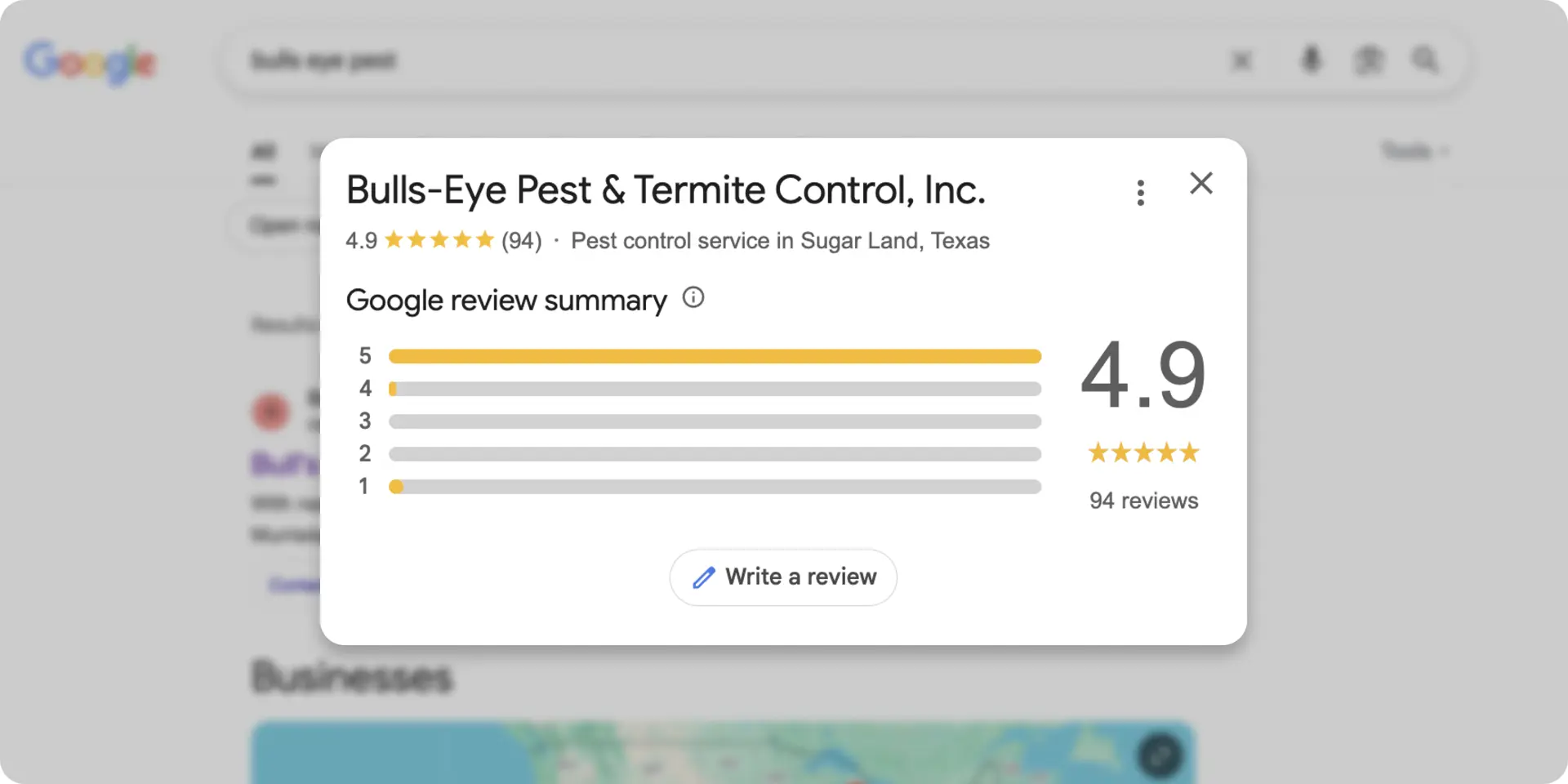
Why does all this reputation work matter so much? Because trust directly impacts your bottom line. Imagine a homeowner finds three pest control companies in a Google search – if your company has 4.8 stars with a hundred reviews, and others have 3-star averages or very few reviews, you’re going to get the first call nearly every time.
Action Item: If you haven’t claimed and optimized your Google Business Profile, do that right away. It’s free and arguably your most important online listing. Keep your information up to date (hours, phone, services), add photos, and collect Google reviews consistently. A strong Google profile with great ratings is often the first impression people have of your business – make it count.
Leverage the Best Digital Marketing Channels
When it comes to reaching homeowners at the exact moment they need pest control, digital marketing is your best friend. The majority of pest control customers begin their search online – typically on Google – to find a service provider. By establishing a presence across the right digital channels, you ensure your business is discoverable and enticing. Here are the digital marketing channels that work best for pest control and why they’re effective:
1. Search Engine Optimization (SEO)
SEO (Search Engine Optimization) means optimizing your online content so that your business appears high in organic (unpaid) search results. For pest control, local SEO is especially crucial because people search for “[your city] pest control” or specific services like “termite exterminator near me.” Good SEO helps you rank for those queries. Key aspects include:
- Keyword-optimized website content: Make sure your website’s pages mention all your key services and the areas you serve. Create dedicated pages or sections for major services (termites, rodents, bed bugs, etc.) with local keywords (e.g., “Ant Control in Madison, WI”). This increases your chances of appearing when someone searches for that pest + location. Blogging about seasonal pest issues and prevention tips can also target long-tail keywords and showcase your expertise.
- Google Business and local citations: As noted, your Google Business Profile is vital – it feeds Google the info to display you in the local map pack. Ensure your name, address, and phone number (NAP) are consistent across all directories (Yelp, Bing, HomeAdvisor, Angi, etc.). These listings and customer reviews send signals that increase your local search ranking.
- Backlinks and authority: When other reputable sites link to your website (for example, a local HOA website listing you as a recommended vendor, or a chamber of commerce directory), it raises your site’s authority in Google’s eyes. Local partnerships can naturally earn you these backlinks. You can also publish helpful content that others might reference (like a guide to keeping mosquitoes away – local bloggers or news might link to it).
- Mobile-friendly site speed: Many panicked homeowners are searching on their phones as they stare at a wasp nest in the yard. If your site is slow or hard to use on mobile, they’ll bounce to another. Good SEO includes having a fast-loading, mobile-optimized website that immediately shows how to contact you and book service.
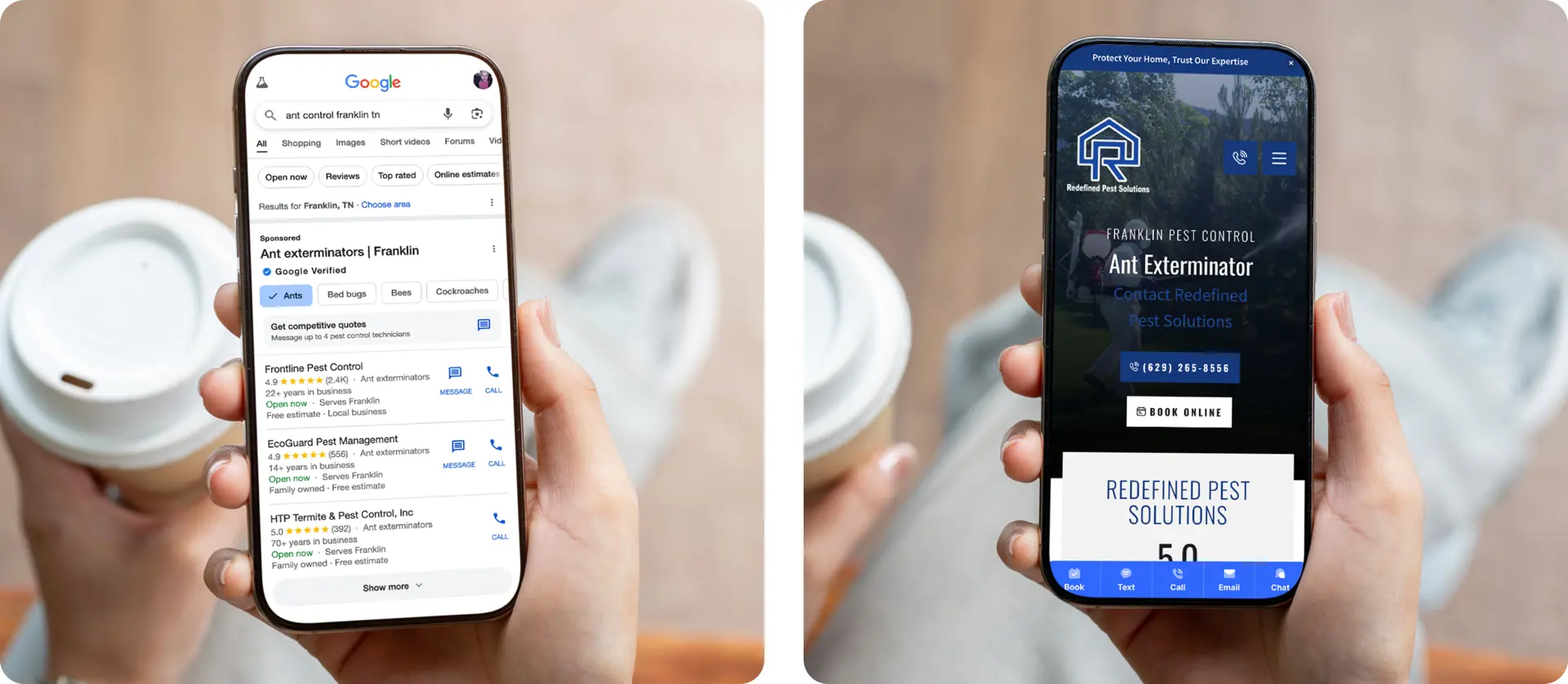
Effective SEO is a long-term play, but it pays dividends by continuously bringing in free leads. A strong ranking is like owning prime real estate on the internet. Pest control companies that invest in SEO often see huge returns.
Clients using Scorpion’s Ranking AI technology saw over 50% of their target keywords reach page one within 3 months, driving a 26% increase in organic traffic
2. Pay-Per-Click (PPC) Advertising
While SEO builds long-term presence, pay-per-click advertising (PPC) – typically Google Ads – can produce immediate visibility at the top of search results. With PPC, you bid on keywords so that your ad appears when people search those terms, and you pay each time someone clicks your ad. For pest control, PPC is powerful because you can target high-intent searches like “exterminator near me,” “get rid of roaches fast,” etc. Some tips for PPC:
- Use geo-targeting: Limit your ads to the geographic areas you service (by city or zip code radius). There’s no point paying for clicks from outside your territory. You can also adjust bids to spend more on specific high-value zip codes (for example, areas where you want to increase market share or neighborhoods with higher-income homes likely to opt for big services like termite jobs).
- Time your ads: You might choose to run ads more heavily during peak pest seasons or even certain days/times. For emergency pest calls, running ads 24/7 might make sense so you catch late-night frantic searches (if you offer 24-hour service). Or if your office only answers phones during business hours, you might concentrate budget then but use an answering service off-hours. Align your ad schedule with when you can best capture and service leads.
- Target specific services: Create separate ad campaigns for your major services – e.g., one for termite control, one for general pest/bugs, one for rodent removal, one for mosquito treatment, etc. Tailor the ad copy and landing page for each. Someone searching “bed bug exterminator” should see an ad that specifically mentions bed bug elimination and maybe offers a free inspection for that issue, leading to a page all about your bed bug program. Specific ads yield higher relevance and conversion rates than one-size-fits-all ads.
- Optimize landing pages: Where you send the click matters. Instead of your homepage, use dedicated landing pages with a strong call-to-action (CTA). If your ad says “Call now for a free quote,” the landing page should prominently show a phone number and “Free Quote” form. Reduce friction – make it super easy for the prospect to contact you. Scorpion’s platform, for instance, uses Landing Page AI to quickly deploy high-converting pages aligned with each ad campaign, which can improve conversion rates significantly by matching customer intent.
- Track and refine: Use conversion tracking to see which keywords and ads lead to calls or form submissions. Over time, allocate more budget to the best performers and pause the poor ones. PPC can become expensive if not monitored, but when optimized, it reliably delivers leads at a predictable cost.
3. Local Services Ads (LSAs)
Google’s Local Services Ads (LSAs) are a game-changer for home services businesses like pest control. These are the ads that appear at the very top of Google (even above regular PPC ads) with a “Google Guaranteed” badge. LSAs operate on a pay-per-lead model – you pay only when a customer calls or messages you through the ad. For pest control, LSAs are excellent because:
- Top visibility and trust: Being Google Guaranteed (which requires Google’s background checks and license verification) gives homeowners extra confidence. Your ad will show your rating and number of reviews right up front. It essentially combines the power of your reviews with prime real estate on the search page. If you have strong reviews, LSAs will showcase that, drawing in clicks.
- Cost-effective leads: LSAs often provide leads at a competitive cost. While traditional PPC might charge per click (which may or may not turn into a lead), LSAs charge per actual lead. Given the value of a new customer (especially if they become recurring), that’s usually a solid investment. And if a lead is bogus (spam or clearly not a real customer inquiry), Google offers dispute mechanisms so you don’t pay for it.
- Set budget and pause easily: You can define a weekly budget for LSAs and even turn them off/on in real time. This flexibility is handy if you get fully booked – you wouldn’t want to pay for leads you can’t service. For example, if a sudden swarm of calls comes in due to a local pest outbreak, you might pause ads for a day so your team can catch up.
- Higher intent: Users who go through LSAs are usually ready to book, because Google prompts them with specific questions about the service needed. Many pest control businesses report high booking rates from LSA leads (since by the time you call them, they’ve already indicated they need a “pest control service for ants” or such, making the conversation straightforward).
If you haven’t tried LSAs, it’s worth getting Google Guaranteed and testing it out. It can be a relatively quick way to increase lead volume, especially for common pest problems and general “pest control near me” searches.
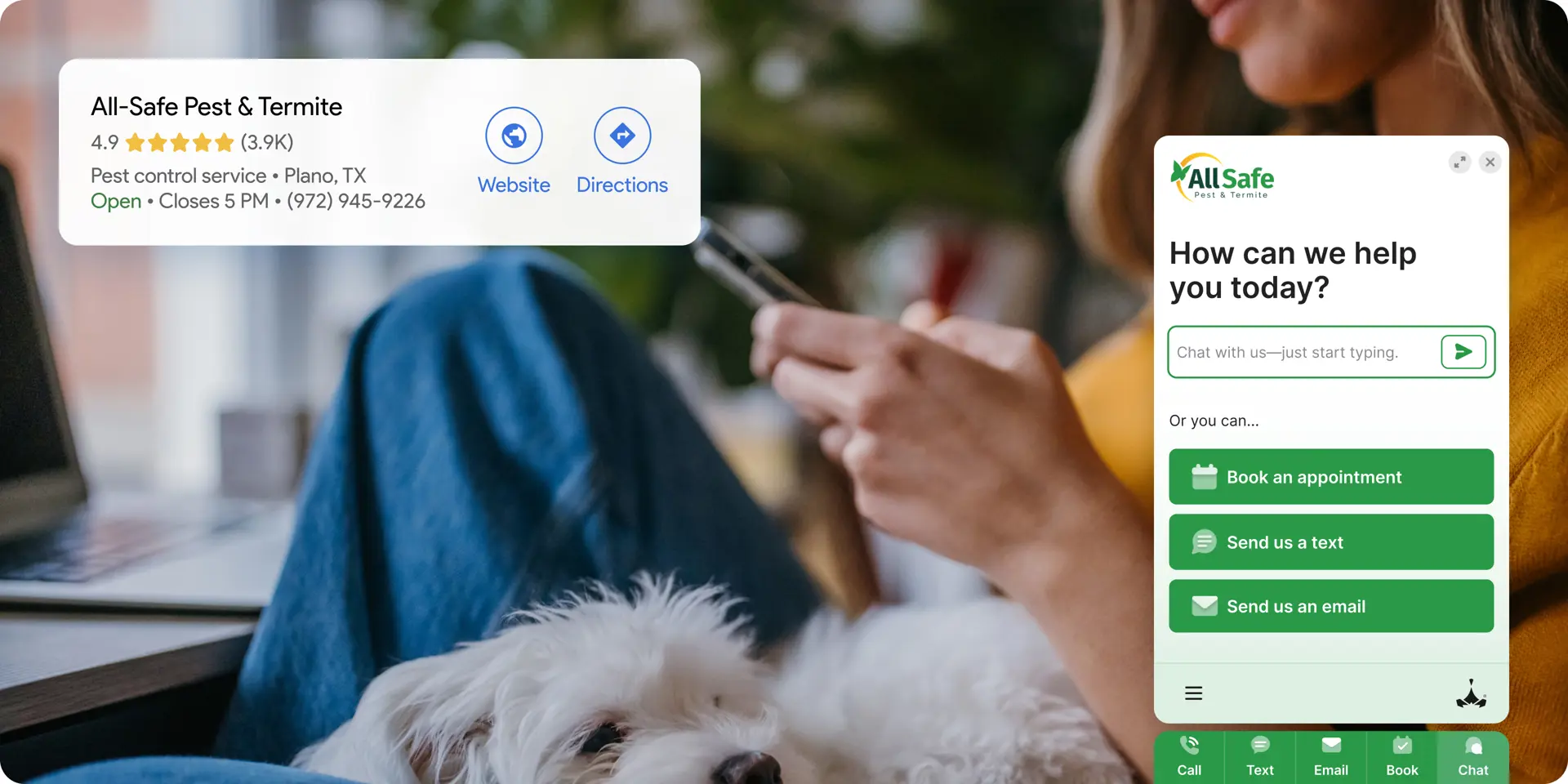
Pairing LSAs with strong review management is key, since your rating affects how often Google shows your ad and which position you get.
4. Other Digital Channels: Social Media and Email
The big three above (SEO, PPC, LSAs) are typically the highest ROI for pest control marketing. However, a well-rounded strategy might also incorporate:
- Social media marketing: While homeowners might not go to Facebook or Instagram to find a pest control company, having a social media presence can reinforce your brand and trust. Use Facebook to share educational tips (e.g., how to spot termite damage early, or seasonal reminders like “check for standing water to reduce mosquitoes”). This positions you as the helpful expert. You can also run targeted Facebook Ads to homeowners in your service area with promotions or seasonal offers. Social ads can generate awareness and sometimes leads (especially for something like a seasonal mosquito package).
- Email marketing: Don’t overlook email, especially for staying in touch with past customers and leads. A monthly or quarterly newsletter with pest prevention tips, seasonal service reminders, and occasional promotions can bring back repeat business. For example, each spring you might send an email about termite swarming season, advising an inspection – with a promo for a discounted termite plan. Email is a low-cost way to nurture your customer base and leads who weren’t ready to buy on first contact.
- Retargeting Ads: Ever noticed ads “following” you around after you visit a site? That’s retargeting. You can use Google or Facebook retargeting to show your ads to people who visited your website but didn’t convert. Maybe someone visited your bed bug treatment page – you can have an ad later appear while they browse YouTube or Facebook saying “Still battling bed bugs? We can help – call for a free quote.” This keeps you top-of-mind and can recapture potential customers who wandered off.
Integrating Channels for Better Results: The best results often come when these channels support each other. For instance, strong SEO plus PPC means you occupy multiple spots on the results page (maybe you appear in the top ads, the local pack via your Google Business listing, and the organic results – that dominance hugely increases the chance of a click). Reviews help both SEO and LSAs. Social media engagement can indirectly improve SEO (via more branded searches or backlinks if content gets shared).
If someone sees your Facebook post about spring pests, then later sees your name again on Google when they have a need, that repetition builds familiarity and trust, making them more likely to choose you.
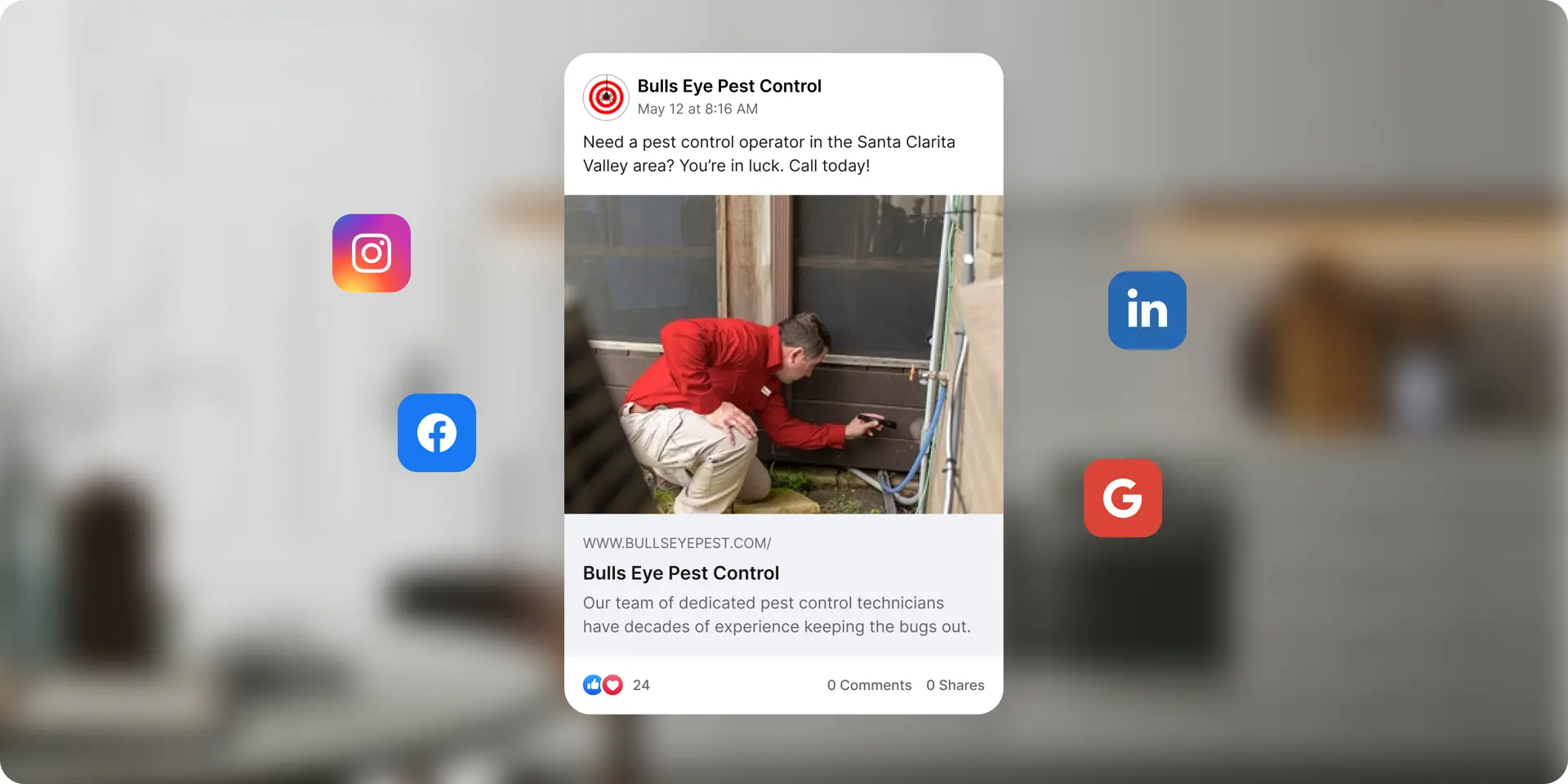
Market with Seasonality and Route Density in Mind
Two unique aspects of pest control operations that should influence your marketing are seasonality and route density. By planning campaigns around seasonal pest patterns and focusing on geographic concentration of customers, you can maximize your efficiency (and profits). Let’s break down each:
Seasonality: Timing Your Marketing for Pest Peaks
Different pests become active at different times of year, and consumer demand for pest control follows these patterns. Rather than deploying a flat, one-size-fits-all marketing approach year-round, savvy pest control marketing will anticipate seasons:
- Spring and early summer – In many regions, this is when insects come roaring back. Ants invade kitchens, termites swarm, wasps and hornets build nests. It’s prime time for general pest control services and termite inspections. Marketing focus: ramp up advertising in late winter/early spring to capture this upswing. Run campaigns like “Spring is termite season – schedule your inspection now!” and ensure your SEO content around ants, wasps, etc. is refreshed before spring hits. Perhaps offer spring pest checkups as a promotion.
- Mid to late summer – Mosquitoes, ticks, and other outdoor pests are at their worst. People also notice wasp nests as they spend time outdoors. Marketing focus: Promote your mosquito control programs (e.g., monthly yard treatments) at the start of summer. Use social media to share tips on avoiding mosquito bites (positioning your service as the ultimate solution). Pest control isn’t just indoors – remind customers you can reclaim their backyards from biting pests.
- Fall – As temperatures drop, rodents seek shelter indoors, and spiders/crickets might surge. Also, stinging insect activity can spike in early fall as wasps get aggressive. Marketing focus: Emphasize rodent proofing and removal services. A campaign like “Don’t let mice make your home theirs this fall – call us for a rodent prevention plan” can resonate. Also, many homeowners think about winterizing; include pest prevention as part of that conversation (seal up entry points, etc., which your team can handle).
- Winter – Pest activity slows but doesn’t vanish. Rodents are still a concern, and some insects like cockroaches may be more noticeable indoors. Also, winter is a great time to remind folks of year-round plans (so they’re ready before spring). Marketing focus: lower your ad spend if demand truly drops, but pivot messaging to off-season topics: “Peace of mind all winter – and a pest-free spring ahead – starts with our annual service plan.” You might run a holiday discount on annual plans as a gift to the household. Content-wise, winter is a good time for homeowner education (e.g., send a newsletter about pest-proofing decorations from attic critters, or how spring will be easier if they act in winter).
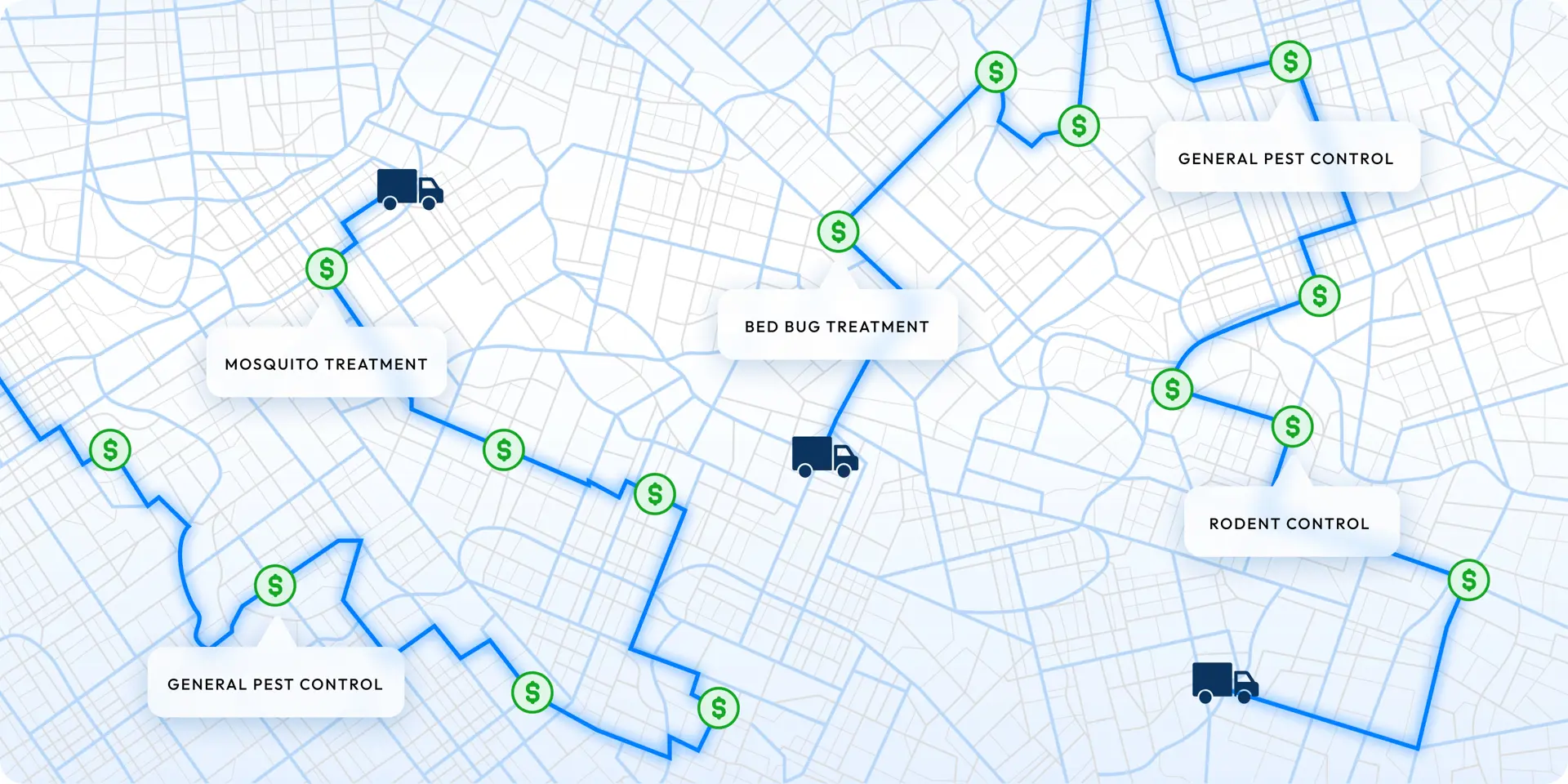
By aligning marketing with these seasons, you ensure you’re top-of-mind when the need is highest. You can also manage your resources better – for instance, generate leads earlier for spring so you can schedule them evenly rather than get overwhelmed in one month. A bit of foresight goes a long way.
Don’t disappear in the off-season.
Even if new leads slow, use that time to double down on SEO (content creation), gather reviews, and market to existing customers. This keeps your pipeline warm. One pest control business noted that by maintaining a baseline of marketing through winter, they hit the ground running in spring and grew their customer base faster than competitors who went dark after summer. Consistency is key, with intelligent ebbs and flows.
Route Density: Owning the Neighborhood
Route density refers to how geographically concentrated your customer jobs are. High route density means you have many customers in a tight area, so techs spend minimal time driving between jobs (reducing “windshield time”) and more time treating pests. This efficiency can greatly increase your profit (less gas, less unbillable time, more slots for jobs per day). Marketing with route density in mind means targeting your advertising and sales efforts to cluster customers nearby one another. Here’s how:
- Geo-targeted campaigns: We touched on geo-targeting in PPC – you might go further by zeroing in on specific ZIP codes or neighborhoods. For example, let’s say you have a strong cluster of customers in the Westfield subdivision but none in the adjacent Maple Heights area yet. You could run Facebook ads or direct mail specifically to Maple Heights residents offering a “new neighbor” discount. Mention that you’re already helping many of their neighbors (if true) – people like knowing a company is experienced in their community.
- Neighborhood referral programs: Encourage your existing customers to refer nearby friends. “Refer a neighbor, you each get $25 off your next service.” If Mrs. Jones on Oak Street refers her friend two doors down, your tech can service both in one trip, which is gold. Over time, these referrals can snowball to you dominating a whole neighborhood. When a new lead from an area calls, ask how they heard of you – if it’s through an existing customer, make sure to thank and maybe reward that referrer.
- Local partnerships: Align with HOAs or community associations. Perhaps sponsor a neighborhood newsletter or attend their community events (e.g., set up a booth at the summer block party). If an HOA includes your flyer or coupon in their welcome packets to new residents, that can quickly establish multiple customers on the same street. Being visible in a community builds trust and interest.
- Use route data for marketing insight: This is where tools like FieldRoutes become very handy. Your route software can show maps of client density. Identify gaps where you drive far between stops. Those gap areas are costing you. Share these insights with your marketing team (or use an integrated system like Scorpion’s that automatically uses this data) to focus marketing efforts in those under-served pockets. For instance, if you see only one client in a large neighborhood that’s 20 minutes from the next stop, target that area with Google Ads (you can target by radius or even drop a pin on that area in Ad settings). Fill in the gap so next time, your tech has 3–4 jobs in that neighborhood instead of one.
- Own the neighborhood: There’s a saying in local marketing: it’s better to dominate one neighborhood than be unknown across an entire city. If you’re known as “the neighborhood pest expert” in several densely populated communities, you’ll have a highly profitable route structure. From there you expand outward. This hyper-local focus can be reinforced by tactics like yard signs (with permission, leave a sign after a mosquito service: “Mosquitoes controlled by [Your Company]”), which neighbors will notice, or even door hanger flyers on the same street you just serviced saying “We helped your neighbor at 123 Maple Drive – call us to get the same pest-free home!” These might seem old-school, but combined with digital retargeting (serving an online ad to that same neighborhood saying “We’re in your area this week!”) it creates multiple touchpoints that can convert nearby prospects.
Result: Increased route density means your team can handle more appointments per day with less travel fatigue and cost. This increases your capacity and ROI on each customer.
Pro Tip: Use your existing customer data to plan marketing. If you integrate FieldRoutes (or your CRM) with your marketing platform, you can map revenue by zip code or neighborhood. For instance, Scorpion is the only preferred digital marketing partner of FieldRoutes, meaning their system can sync with FieldRoutes to identify exactly which areas generate the most revenue and which types of jobs are most profitable. It’s a smart way to grow “wide and deep”: wide by covering more of your service territory, and deep by saturating each area for density.
Use Integrated Tools to Maximize ROI and Efficiency (FieldRoutes + Scorpion’s RevenueMAX)

Running a pest control business involves juggling marketing, sales, scheduling, and service delivery. Without integrated tools, you risk missing opportunities or wasting resources. By connecting field management software like FieldRoutes with a marketing platform such as Scorpion’s RevenueMAX, you gain real-time data to drive smarter decisions, improve efficiency, and boost returns. Here’s how integration benefits your business:
Real-time insights for smarter marketing
FieldRoutes manages your customers, routes, and billing, while RevenueMAX connects that data to your marketing efforts. This integration reveals exactly which jobs and neighborhoods generate the most revenue, so you can automatically allocate marketing budget toward your most profitable services and locations. It removes guesswork, ensuring your dollars always go toward activities proven to deliver revenue.
Higher-quality leads directly into your CRM
Integration means leads from your website, ads, and chat flow directly into your CRM (such as FieldRoutes) with all relevant details. You can instantly see a lead’s specific pest problem or location, allowing quick, effective follow-ups. This closed-loop tracking helps pinpoint precisely which marketing efforts produce booked jobs and actual revenue, not just calls or clicks.
Smart scheduling reduces windshield time
Integration enables your marketing and operations to communicate in real time. For instance, if FieldRoutes shows available time slots in certain neighborhoods, RevenueMAX can automatically target ads or promotions there to fill gaps. Conversely, if your schedule is full in one area, the system reallocates marketing spend elsewhere. This leads to tightly clustered appointments, reducing driving time and increasing technician productivity.
24/7 lead capture and seamless follow-up
Scorpion’s integrated solutions also offer tools like AI Chat that interact with website visitors anytime, answering questions or scheduling appointments directly into FieldRoutes—even when your team isn’t available. Additionally, tools like Leads AI analyze incoming calls and web inquiries, prioritizing the most promising leads for faster, more effective follow-ups. No leads slip through the cracks, and your customer experience stays consistent and responsive.
Clear, measurable ROI
Integrated reporting provides total transparency on your marketing effectiveness. Scorpion’s platform includes ROI dashboards showing exactly how each marketing channel—SEO, PPC, or Local Services Ads—translates to booked jobs and revenue. For example, your dashboard may show that a $2,000 investment generated $20,000 in revenue (a clear 10x return).
Putting it all together
Imagine a busy spring: FieldRoutes data shows one area fully booked but another with plenty of openings. RevenueMAX automatically boosts ads in the less-booked area, generating leads that efficiently fill your technicians’ schedules. Completed jobs prompt automatic review requests, strengthening your online reputation. Customer and revenue data continuously refine your strategy, forming a powerful cycle of improvement: leads → booked jobs → revenue insights → smarter marketing.
Integrating FieldRoutes and RevenueMAX streamlines your operations, improves decision-making, and ultimately helps your pest control business attract higher-quality leads and grow revenue consistently.
Partner with Experts and Grow Your Pest Business
Marketing can feel overwhelming at times – especially when you’re busy running the day-to-day of your pest control company. The good news is you don’t have to do it all alone. Partnering with marketing experts who understand the pest control industry can accelerate your growth and let you focus on what you do best (delivering great service).
Scorpion, for example, has a proven track record in pest control marketing, from driving leads to building brand presence. In 2024 alone, Scorpion helped generate 145,000+ pest control leads, and has helped clients achieve record revenue numbers with RevenueMAX.
Contact Scorpion’s team today to learn how RevenueMAX can drive more jobs and revenue for your pest control business. We’re here to help you reduce wasted time, maximize your marketing ROI, and achieve the growth you’ve been working toward. With revenue-driven marketing on your side, you can build the pest control company of your dreams – one that’s thriving, resilient, and the go-to choice for homeowners in your community.
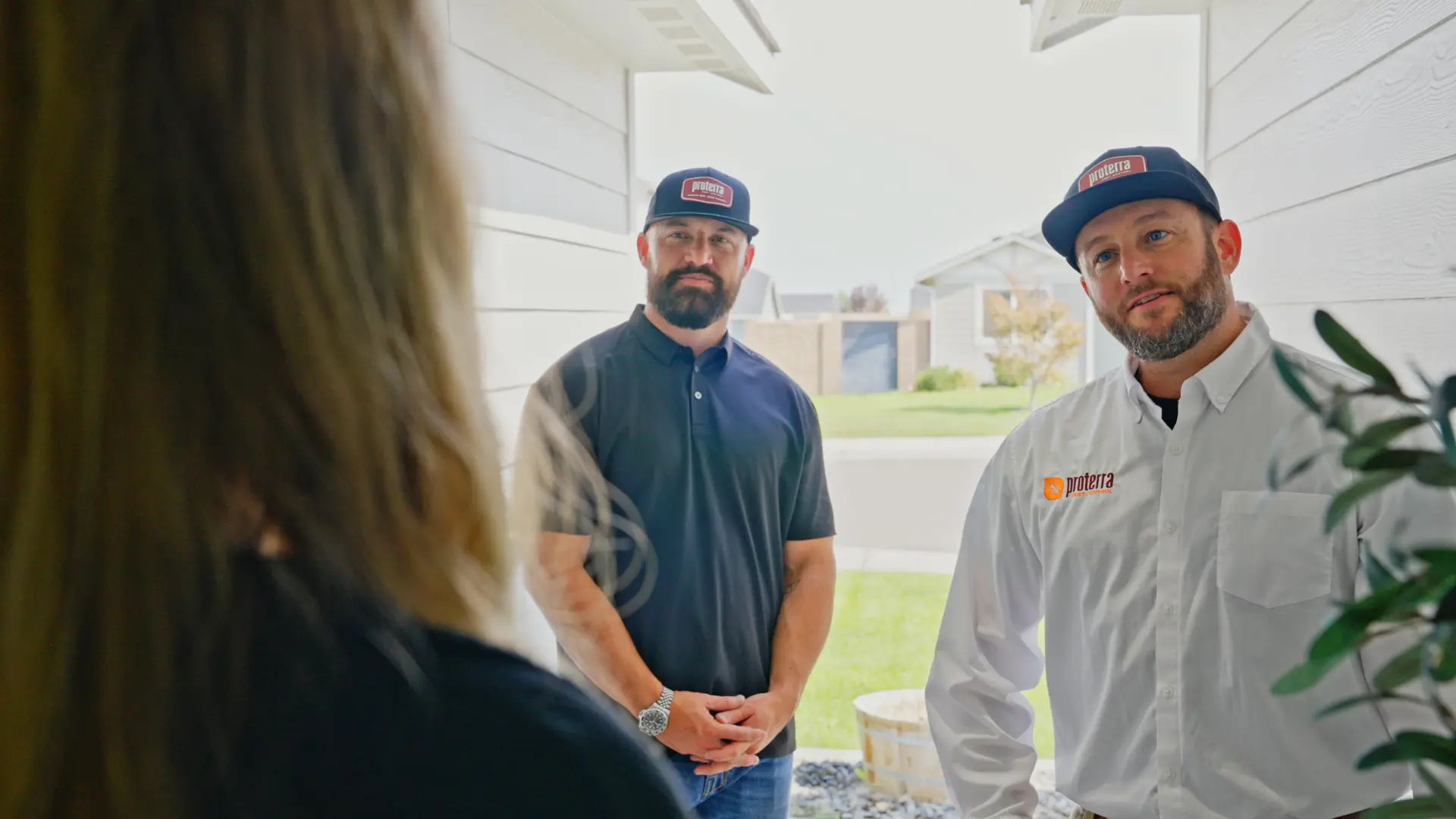



-Copy-01.00_32_28_22.Still015.jpg.0000000000000.webp)
-Copy-01.00_32_48_11.Still013.jpg.0000000000000.webp)
